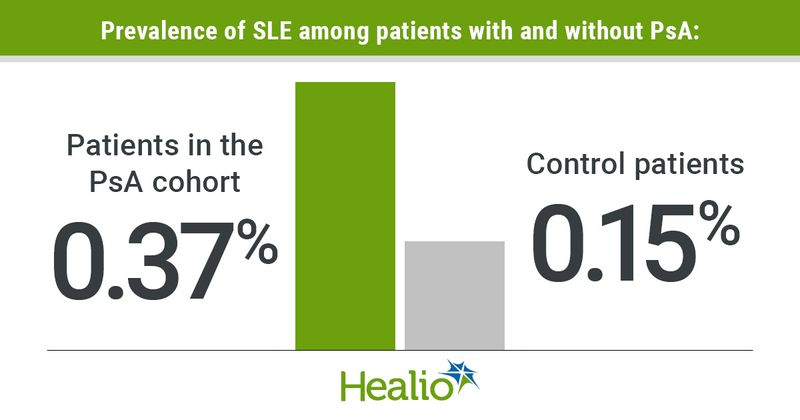SLE twice as prevalent among patients with psoriatic arthritis
Click Here to Manage Email Alerts
Systemic lupus erythematosus is 2.3 times more prevalent among patients with psoriatic arthritis compared with the general population, according to data published in The Journal of Rheumatology.
“The presence of antinuclear antibodies (ANA) is one of the hallmarks of SLE,” Danielle Korkus, MD, of the Technion-Israel Institute of Technology, in Haifa, and colleagues wrote. “Several studies report a higher prevalence of ANA positivity in patients with psoriasis and PsA. Previous studies also report a coexistence of psoriasis and SLE, but unlike psoriasis, the coexistence of PsA and SLE has only been reported in several case reports.”

To examine the prevalence of SLE among patients with PsA, compared with those in the general population, Korkus and colleagues analyzed information from the Clalit Health Services database. According to the researchers, this database serves approximately 52% of the population of Israel and includes continuously updated information from pharmaceutical, medical and administrative operating systems. Focusing on data from 2002 to 2017, the researchers analyzed a cohort of 4,836 patients with PsA and compared them with 24,180 without PsA.
Individuals in the two cohorts were matched based on age and sex, with randomly selected controls for demographics, clinical and laboratory manifestations, and dispensed medications. The statistical analysis included t-tests and chi-square tests as appropriate. In the PsA group, Korkus and colleagues conducted incidence density sampling, matching patients with PsA but without SLE as controls to each case of PsA with SLE, based on age and follow-up time. In addition, the researchers used univariable and multivariable conditional logistic regression analyses to assess factors that impact SLE development.
According to the researchers, 18 patients in the PsA cohort, or 0.37%, were diagnosed with SLE, compared with 36 individuals in the control group, or 0.15% (P = .001). Patients with SLE but without PsA demonstrated higher anti-dsDNA and anticardiolipin antibodies. In addition, the use of treatments that are known to potentially induce SLE was higher in the PsA cohort compared with controls. Among those with PsA, older age at diagnosis, shorter duration, and statin treatment were associated with developing SLE.
“Our study points to an increase in prevalence of SLE among female patients with PsA, with patients at the highest risk of SLE development being female patients with late-onset PsA, short disease duration, and especially with statin therapy,” Korkus and colleagues wrote. “Clinicians caring for patients with PsA and SLE should be aware of the higher prevalence of comorbid conditions in this patient population. More research is needed to understand the underlying biologic pathway that may be common to SLE and PsA.”

